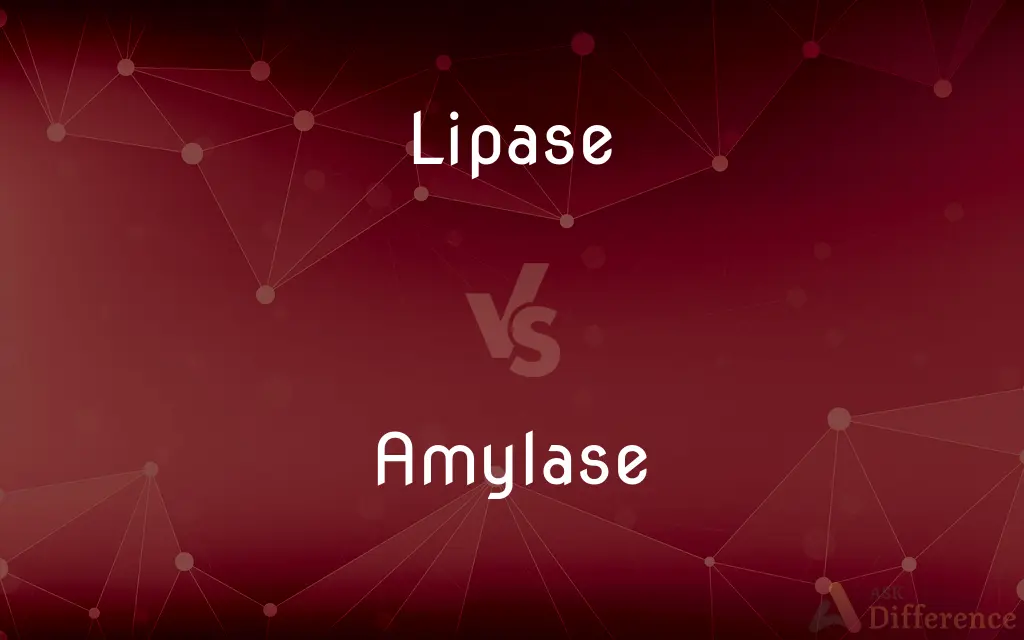Lipase vs. Amylase — What's the Difference?
By Tayyaba Rehman — Published on November 11, 2023
Lipase and amylase are enzymes, but lipase breaks down fats into fatty acids and glycerol, while amylase breaks down starches into simpler sugars like maltose and glucose.

Difference Between Lipase and Amylase
Table of Contents
ADVERTISEMENT
Key Differences
Lipase and Amylase are crucial enzymes, assisting in our digestive processes. Lipase specifically targets fat molecules. Its primary function is to facilitate the breakdown of fats into glycerol and fatty acids, aiding in digesting, transporting, and processing dietary lipids (fats). On the other hand, Amylase plays a distinct role in our digestive system by focusing on carbohydrates. It converts starches into simple sugars, such as glucose and maltose, easing the further processing and absorption of carbohydrates. These enzymes are both vital but serve unique functions in maintaining digestive health.
In regard to the specificity in their function, Lipase focuses singularly on fat molecules. It gets secreted by the pancreas into the small intestine, where it acts upon the fats we consume, breaking them down to facilitate absorption. Amylase, too, is secreted by the pancreas but is also found in saliva. It begins acting on the food right from the mouth, starting the process of carbohydrate breakdown from the get-go, showcasing its specificity towards starch molecules.
A further dive into the role of Lipase shows that it doesn’t only participate in digestion. It also plays a part in cellular processes and is involved in varied aspects like immune function and cell permeability. Amylase, while recognized for its pivotal role in digestion, is also instrumental in determining the energy availability from our diet since it helps make sugars, the primary energy source, available for absorption.
Considering conditions and diseases, Lipase levels are often scrutinized when assessing pancreatic health. Elevated levels can be an indicator of pancreatic inflammation or pancreatitis. Amylase, too, is considered a biomarker for pancreatic health. However, altered levels could signify issues beyond the pancreas, like salivary gland issues or gastrointestinal disorders, due to its broader localization within the body.
In the clinical field, Lipase is often gauged through blood tests when diagnosing and monitoring pancreatitis and other pancreatic conditions. Amylase, while also assessed through blood tests, may be scrutinized for a variety of conditions like mumps, macroamylasemia, and more, due to its broader localization and varied roles.
ADVERTISEMENT
Comparison Chart
Primary Function
Breaks down fats into fatty acids and glycerol
Breaks down starches into simpler sugars
Secretion Location
Primarily pancreas
Pancreas and salivary glands
Role Beyond Digestion
Involved in cellular processes, immune function
Influences energy availability from the diet
Health Indications
Elevated levels indicate pancreatic inflammation
Altered levels may indicate various conditions
Subtypes
Includes pancreatic lipase, hepatic lipase, etc.
Includes alpha-amylase, beta-amylase, etc.
Compare with Definitions
Lipase
Lipase is an enzyme that catalyzes the breakdown of fats to fatty acids and glycerol.
Lipase facilitates the digestion of ingested oils and fats in our diet.
Amylase
There are different types of amylase, including alpha-amylase and beta-amylase, each with specific roles.
Alpha-amylase, found in our saliva, initiates the digestive process as soon as we begin chewing.
Lipase
Lipase enzymes can originate from various sources like the pancreas, liver, and even certain plants.
Some detergents contain lipase derived from microbial sources to break down fat stains.
Amylase
Amylase is an enzyme that converts starches into simple sugars during digestion.
Amylase begins its work in the mouth, initiating the breakdown of bread into simpler sugars.
Lipase
Lipase also participates in cellular processes beyond digestion, including cell permeability and immune function.
Research indicates that lipase can influence certain immune responses within the body.
Amylase
Amylase plays a vital role in carbohydrate metabolism and energy provision.
Amylase ensures that the body can absorb and utilize carbohydrates efficiently for energy.
Lipase
Lipase serves a crucial role in lipid metabolism and absorption in the digestive system.
Without adequate lipase, fat digestion and absorption can be significantly impaired.
Amylase
Amylase levels in the blood are often tested to gauge pancreatic and salivary gland health.
Elevated amylase levels in blood tests might indicate a pancreatic disorder or other health issues.
Lipase
Lipase, specifically pancreatic lipase, is often measured to assess pancreatic health.
The doctor ordered a lipase test to check for possible pancreatitis in the patient.
Amylase
Amylase is not only found in humans but also in plants, aiding in the breakdown of starch reserves.
Plant seeds contain amylase, which helps convert stored starch into sugar during germination.
Lipase
Any of a group of enzymes that catalyze the hydrolysis of fats into glycerol and fatty acids.
Amylase
Any of a group of enzymes that catalyze the hydrolysis of starch to sugars. In humans, amylases are produced in the salivary glands and the pancreas.
Lipase
(enzyme) Any of a group of enzymes which catalyses the hydrolysis of lipids.
Amylase
(enzyme) Any of a class of digestive enzymes, present in saliva and also contributed to the gut by the exocrine pancreas, that break down complex carbohydrates such as starch into simpler sugars such as glucose.
Egg yolk amylase
Lipase
An enzyme secreted in the digestive tract that catalyzes the breakdown of fats into individual fatty acids that can be absorbed into the bloodstream
Amylase
Any of a group of proteins found in saliva and pancreatic juice and parts of plants; help convert starch to sugar
Common Curiosities
Are Lipase and Amylase secreted from the same organ?
No, while both are secreted by the pancreas, amylase is also secreted by the salivary glands.
What indicates a problem regarding Lipase levels in medical testing?
Elevated Lipase levels may indicate pancreatic issues, such as pancreatitis.
How does Amylase contribute to the digestive process?
Amylase breaks down starches into simpler sugars, such as maltose and glucose.
What dietary components do Lipase and Amylase act upon?
Lipase acts on fats, while Amylase acts on starches.
Can you identify Lipase and Amylase in everyday items or processes?
Yes, they're used in various industries, such as food, biofuel production, and even in laundry detergents.
Can I find Lipase and Amylase outside the human body?
Yes, both enzymes are found in various organisms, including plants and microbes.
Why might a doctor check Amylase levels during a health assessment?
Amylase levels can be indicative of pancreatic health, salivary gland issues, or gastrointestinal disorders.
What is the primary function of Lipase in the body?
Lipase breaks down fats into fatty acids and glycerol during digestion.
What are some sources of Lipase outside of the human body?
Microorganisms, plants, and certain animal organs (like the pancreas) are sources of Lipase.
Is it possible to have deficiencies in Lipase or Amylase?
Yes, deficiencies or abnormalities in these enzymes can lead to digestive issues.
How are Lipase and Amylase related to metabolic processes?
Lipase is crucial for fat metabolism, while Amylase is essential for carbohydrate metabolism.
Can issues with Lipase and Amylase lead to malnutrition?
Yes, issues with these enzymes can hinder nutrient absorption, potentially leading to malnutrition.
Can I take supplements for Lipase and Amylase?
Yes, enzyme supplements are available and may be recommended for certain digestive disorders.
How are Lipase and Amylase related to nutrition absorption?
They facilitate the breakdown and absorption of fats and carbohydrates, respectively, in the digestive system.
What is the role of Amylase in plants?
In plants, Amylase helps convert stored starches into sugars during seed germination.
Share Your Discovery

Previous Comparison
Amino Acid vs. Nucleotide
Next Comparison
Hard Disk vs. RAMAuthor Spotlight
Written by
Tayyaba RehmanTayyaba Rehman is a distinguished writer, currently serving as a primary contributor to askdifference.com. As a researcher in semantics and etymology, Tayyaba's passion for the complexity of languages and their distinctions has found a perfect home on the platform. Tayyaba delves into the intricacies of language, distinguishing between commonly confused words and phrases, thereby providing clarity for readers worldwide.











































